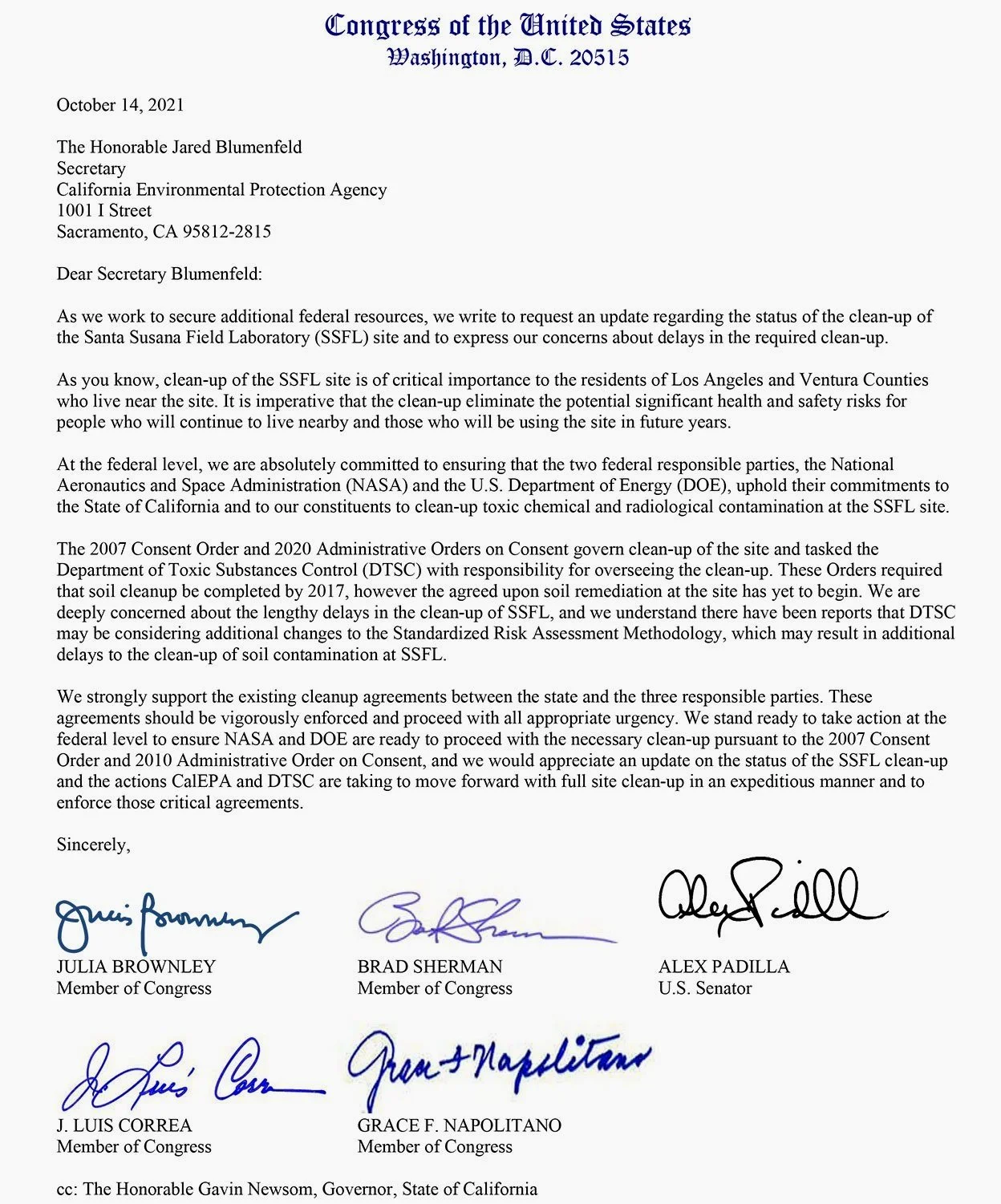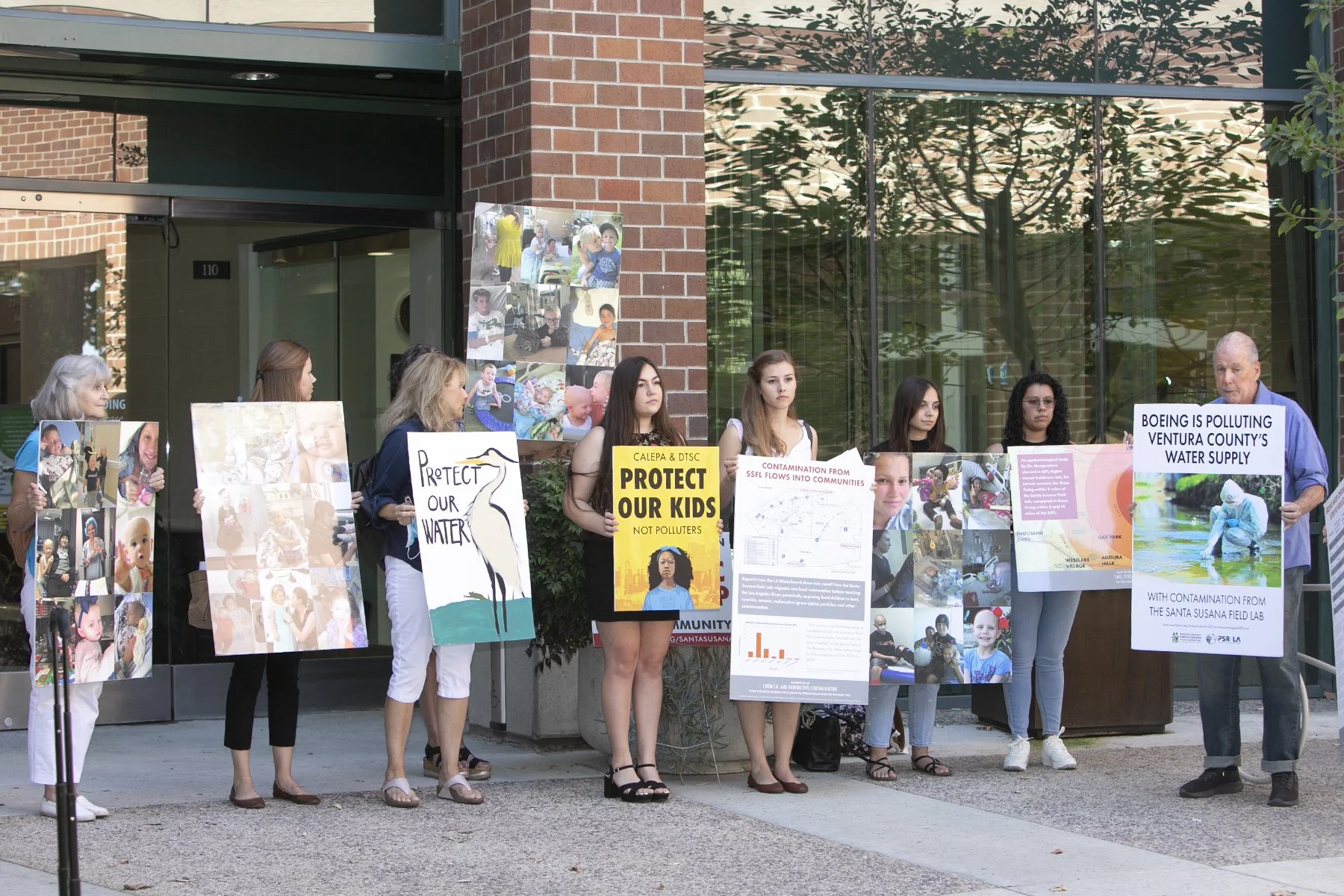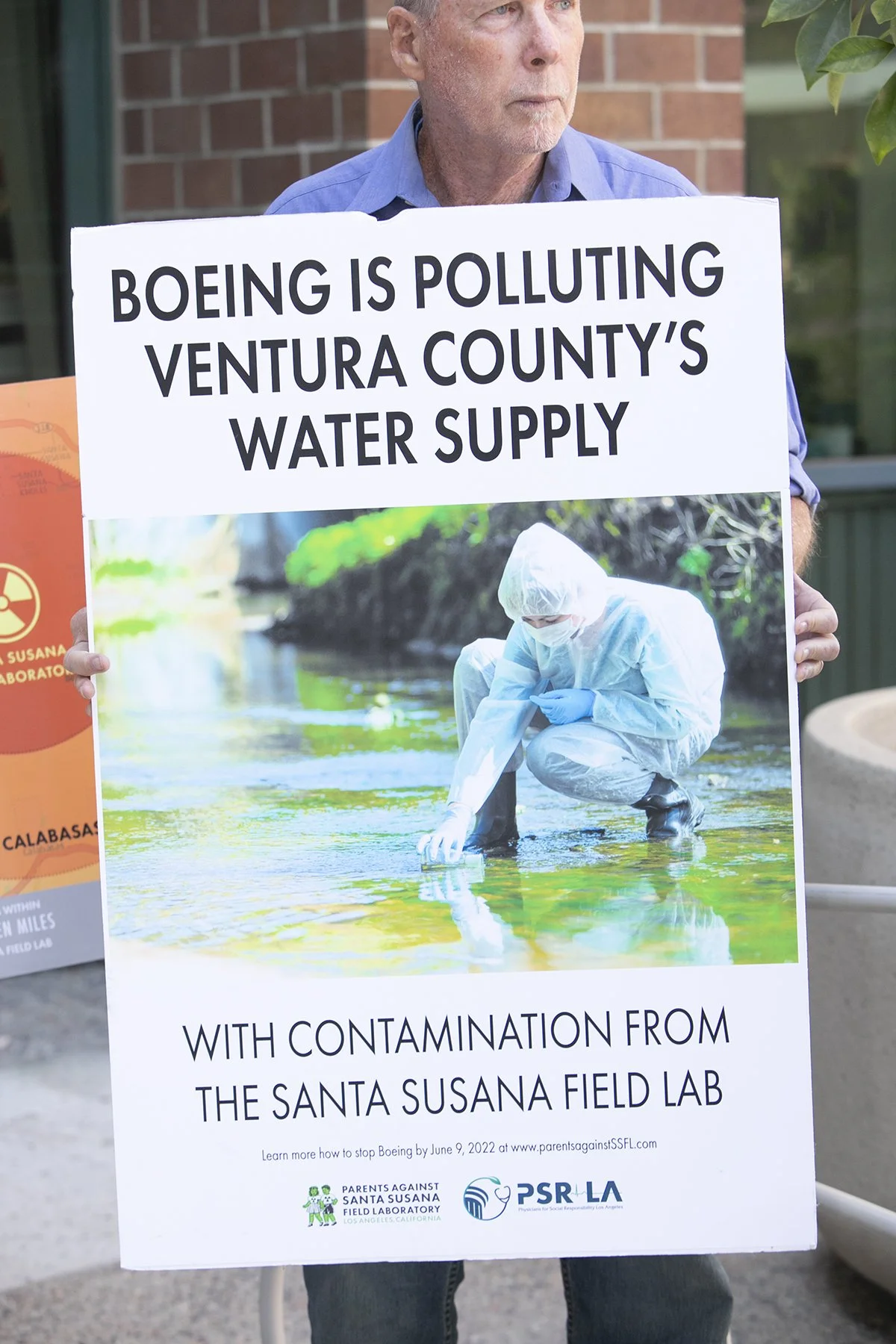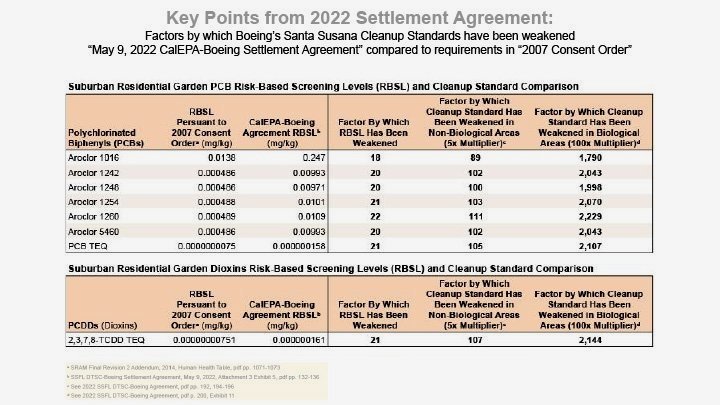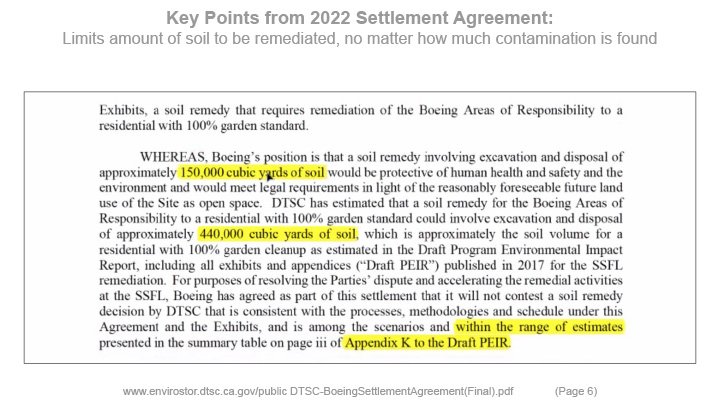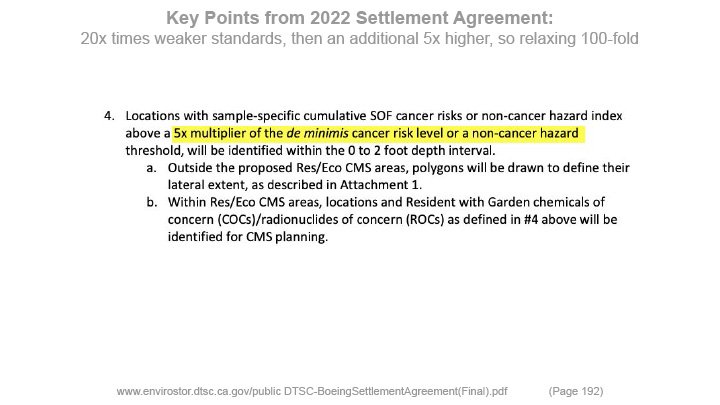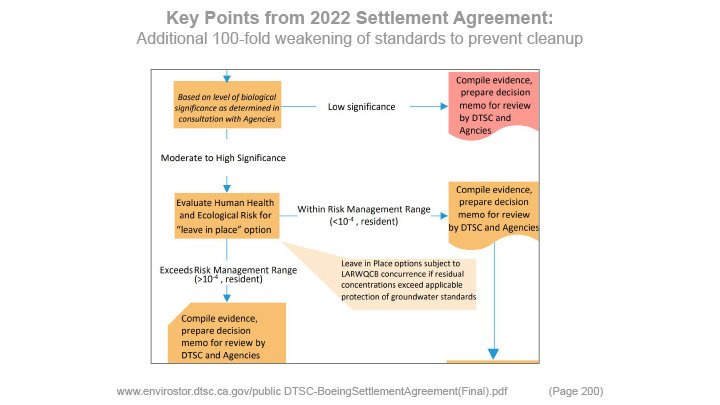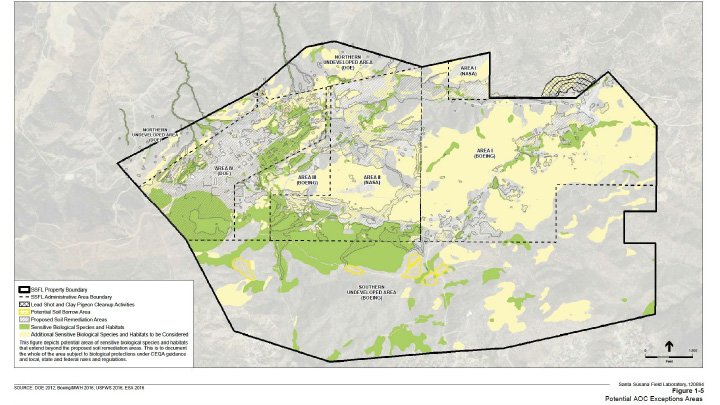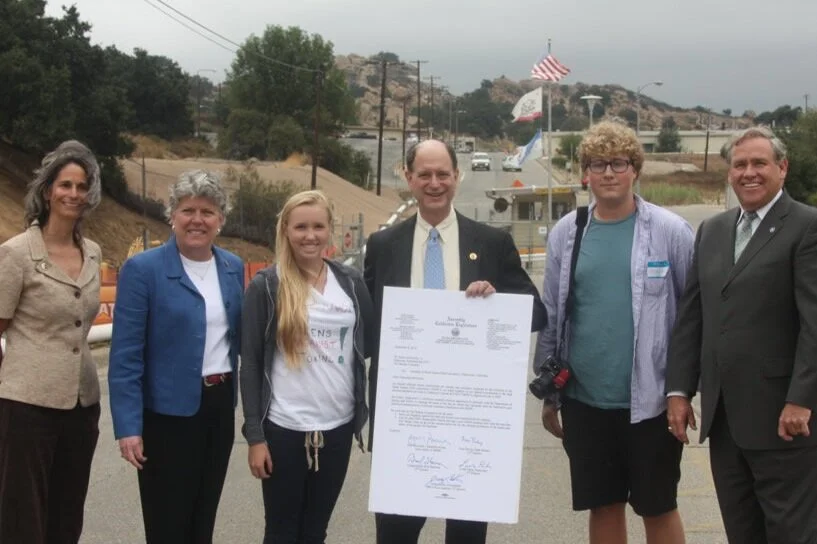
Cleanup Agreements
SSFL > CLEANUP > CLEANUP AGREEMENTS
Cleanup AGREEMENTS
The original, precedent-setting cleanup agreements for the Santa Susana Field Lab have been modified to the point that almost all of the site’s contamination will remain onsite permanently.
The Santa Susana Field Lab (SSFL) is one of the most contaminated sites in California. Decades of nuclear energy experiments and rocket engine testing resulted in extensive pollution of the site’s soil and groundwater. California’s Department of Toxic Substances Control entered into legally binding cleanup agreements with the site’s three Responsible Parties: the Boeing Company, NASA, and the US Department of Energy.
The cleanup agreements were intended to make the site as safe as possible for the 700,000 people who live within 10 miles of the site. Former Republican Governor Arnold Schwarzenegger and former Democratic Senator Barbara Boxer championed the original SSFL cleanup agreement in 2007. Congresswoman Julia Brownley and former State Senator Sheila Kuehl were instrumental in passing the 2010 cleanup agreement that created the unprecedented cleanup to “Background,” that is, to remove all man-made contamination in order to return the site to it’s natural condition.
Currently, Boeing, NASA, and the Department of Energy are working aggressively to lessen the cleanup agreements. If successful, they will leave almost all of the contamination on site, saving them millions of dollars while putting the environment and community at risk. The DTSC is assisting, and not resisting, their efforts.
PASSFL and other NGOs are fighting for a return to the original cleanup agreements to restore the SSFL to it’s condition before it was polluted.
2025
Boeing’s Corrective Measure Study (CMS)
DTSC’s Statement of Basis
Boeing’s CMS document cements the earlier concedes of the Settlement Agreement and PEIR. The primary offenders in the document:
The Corrective Measures Study (CMS) prepared by Boeing and DTSC’s Statement of Basis (SOB) have codified the modified Risk-Based Screening Levels (RBSLs) and arbitrary multipliers introduced under the 2022 “Settlement Agreement.” This revision nullified the Residential with Garden cleanup scenario, aligning it with the far less protective Recreator standard.
Boeing’s sham “Residential with Garden” cleanup, per the CMS, would allow contamination to remain that would exceed the EPA’s 1-in-1,000,000 excess lifetime cancer risk standard—a level intended to protect public health.
It is shameful that DTSC refuses to acknowledge the most basic physical realities—erosion, wind, or even gravity—in its risk assessments, claiming the contamination at the SSFL does not migrate. DTSC also ignores independent studies and data from sister agencies that clearly document offsite contamination.
In Boeing’s CMS, the Generalized Human Health Risk Assessment Conceptual Site Model fails to identify exposure pathways for offsite migration or account for future receptors (Figure 2-2a, PDF p. 114).
The 2022 “Settlement Agreement” SRAM substantially weakens cleanup protections compared to the 2014 SRAM Revision 2 Addendum. To fulfill the original cleanup commitment and safeguard human health, the more protective 2014 standards must be upheld.
Boeing is exploiting so-called “biological and cultural exemptions” to evade responsibility for cleaning up toxic contamination—an action that will harm wildlife and Indigenous communities, not protect them.
Under the 2022 Settlement Agreement, Boeing isn’t required to clean up toxic chemicals unless contamination exceeds five times the already-weakened human health and cancer risk levels (Settlement Agreement p. 192).
In areas designated with biological or cultural exemptions, pollution may remain more than 100 times higher than the agreed-upon safety thresholds (Settlement Agreement p. 200–201).
As of 2022, Boeing is no longer required to consider the increased cancer risk for children. Their cancer model only considers risks to adults. The EPA generally applies the principle that children are at least 10x more susceptible to cancer. (2022 SRAM, PDF p140).
When the Settlement Agreement was released, DTSC stated that Boeing would be remediating radiological contamination on their parcels to a background level. Boeing’s CMS and DTSC’s Statement of Basis do not uphold that promise, and even worse, there is discussion of sending some radiological waste to municipal landfills!
The Residential with Garden Scenario, as weakened in the 2022 Settlement Agreement and implemented in the CMS, will no longer provide a cleanup that is protective of public health- and that reality is being intentionally omitted from the discussion by DTSC’s who’s own toxicologist refused the opportunity to officially weigh in on the CMS document.
The Statement of Basis, DTSC’s official decision document for Boeing’s Corrective Measures Study, reveals systemic regulatory failure. Rather than demonstrating reform, it confirms that DTSC has prioritized the interests of the polluter over its statutory mandate to enforce cleanup standards and safeguard public health.
2024
Department of Energy’s SEIS
The US Department of Energy (DOE) published a notice of intent in the Federal Register on Dec. 27, 2024, to submit a Supplemental Environmental Impact Statement (SEIS) instead of fulfilling its commitment to the AOC cleanup. The DOE claimed that mistakes in prior calculations would make a background cleanup impossible to implement.
These claims were refuted by a letter from the Committee to Bridge the Gap.
2023
Environmental Impact Report (PEIR)
The DTSC released the Final Programmatic Environmental Impact Report (PEIR) on June 8, 2023. According to extensive analysis from our technical advisors, Committee to Bridge the Gap, the PEIR is built on the Settlement Agreement and massively limits the final cleanup of the site, breaking all prior promises for a complete cleanup.
Boeing will be allowed to leave up to 94% of their portion of the site contaminated.
NASA and the Department of Energy will leave 63% of their portion of the site contaminated.
The PEIR eliminates the “background” cleanup from further analysis.
Despite prior resolutions by the Los Angeles and Ventura County Board of Supervisors to sue if the PEIR breached cleanup agreements to “background,” they have not taken action.
The Department of Toxic Substances Control (DTSC) has launched a campaign to convince elected officials that the PEIR isn’t a “decision document” and that they should wait years, possibly decades, for independent resolutions on each section of the PEIR before suing.
One of DTSC’s primary arguments is that they claim the data, such as shown in Table 2.6-1, aren’t final estimates of how much soil will be remediated.
However, during a presentation on the PEIR by the DTSC to the Board of Environmental Safety, their slide admitted that the PEIR assumes maximum estimated soil volume estimates.
This proves our argument that the PEIR is a final decision document as it limits how much soil can be remediated in the final cleanup.
2022
Memorandum of Understanding (MOU)
The Los Angeles Regional Water Quality Control Board voted in favor of Boeing’s Memorandum of Understanding (MOU) on August 11, 2022, despite 300 community members who (virtually) attended the meeting to ask the Board to vote no. The MOU also activated Boeing’s Settlement Agreement with the California Department of Toxic Substances Control (DTSC).
Main arguments against MOU
Agreement promises to remove Boeing’s rainwater discharge permit (NPDES) 10-15 years before cleanup is completed.
MOU gives authority to the Expert Panel, paid by Boeing, to make critical judgements about testing requirements and methodologies.
MOU assumes that the Settlement Agreement will remove all dangerous contamination, therefore Boeing won’t need an NPDES permit to monitor or regulate chemicals flowing offsite and into local waterways.
Elected Officials Concerned about MOU: Federal and local elected officials and governments have expressed concern over negotiations between the DTSC and Boeing, and expressed their support for the stringent 2007 cleanup standards.
Over 310 chemicals have been documented at the SSFL. Some are persistent, lasting in the environment for centuries if not completely remediated. Most are toxic or carcinogenic and can harm both humans and wildlife. Many of the SSFL contaminants have exceeded Boeing’s National Pollution Discharge Elimination System (NPDES) permit levels in the past, despite Boeing’s many promises that they would not allow the contaminated surface water runoff from the SSFL to reach local waterways. Contamination detected in SSFL water runoff has included lead, mercury, arsenic, perchlorate, TCE, dioxins, PCBs, and more.
Contaminated water from the SSFL reaches the Los Angeles River and the Calleguas Creek Watershed, and can pollute water that is:
Used for drinking water in Ventura County. The contamination can disproportionately harm already marginalized and economically disadvantaged communities that can’t afford water filtration systems. These communities are also faced with a lack of access to healthcare.
Percolating into the groundwater. Groundwater is difficult, costly, and extremely slow to remediate.
Irrigates crops, which can contaminate produce grown in Ventura County.
Impacts farmers and farm workers who will be exposed to SSFL contamination while working in the agricultural fields.
Essential to the survival of sensitive and endangered wildlife on and near the SSFL.
Used for recreation, putting people at direct risk of exposure.
En route to the Pacific Ocean, endangering our marine life, ocean, and people.
Sacred to local indigenous tribes.
There is no benefit to the public in discontinuing Boeing’s NPDES permit after the insufficient and dramatically weakened soil cleanup is completed.
Residents protest before the MOU vote by the Water Board. Santa Clarita, 2022.
critiques of MOU
Committee to Bridge the Gap, 2022: Comments on Proposed Memorandum of Understanding Between the Boeing Company and the Los Angeles Regional Water Quality Control Board Regarding the Contaminated Santa Susana Field Laboratory
Heal the Bay, 2022: Calling for Accountability at the Santa Susana Field Lab
2022
Settlement Agreement
CalEPA, DTSC, and Boeing sign a new agreement for the Santa Susana Field Lab cleanup, erroneously titled as the Settlement Agreement. When carefully examined, the 796-page document shows that the new agreement will dramatically weaken the chemical cleanup at the site. Instead of removing most of the chemical contamination, it will leave most of it. Similarly, it will leave most of the groundwater dangerously contaminated. Our community, wildlife and environment will be harmed unless all of the contamination is cleaned up.
PASSFL is currently suing over the Settlement Agreement, along with Physicians for Social Responsibility - Los Angeles and Public Employees Environmental Responsibility (PEER).
Major Faults in Settlement Agreement
The settlement Agreement supersedes most of the 2007 Agreement, resulting in 95% of the contaminated soil remaining on site.
The agreement was negotiated in private without any representatives for the public interest and was agreed to without any public input.
The agreement didn’t include CEQA, a legally required environmental review.
Critique of Settlement Agreement:
Committee to Bridge the Gap:
2022
Boeing groundwater covenant
The groundwater Covenant to last “in perpetuity” with the Boeing Company allows the highly polluted groundwater under the Santa Susana Field Laboratory to remain polluted for “an indeterminate amount of time.”
Read more
2020
CalEPA Promises community
2020, EPA Secretary Jared Blumenfeld publicly promised the community that CalEPA would not negotiate with Boeing over the cleanup and would enforce the 2007 Consent Order Agreement.
2017
Draft Programatic Environmental Impact Report (PEIR)
The Draft PEIR formulated the cleanup alternatives. Three scenarios were highlighted in the Draft PEIR:
The USEPA default-based (with garden) scenario assumes that 25% of all home-grown produce eaten by the resident (over 30 years) is contaminated.
The SSFL SRAM-based (with garden) scenario assumes that 100% of all the home-grown produce eaten by the resident is contaminated.
The SSFL SRAM-based (no garden) scenario assumes no exposure to home grown produce.
The Draft PEIR quotes the 2007 Consent Order, “Cleanup plans ‘shall detail the methodology for developing and evaluating potential corrective measures [cleanup actions] to remedy chemical contamination at the Facility utilizing the Standardized Risk Assessment Methodology (SRAM) Workplan (Rev. 2).
2014
Standardized Risk Assessment Methodology (SRAM) Revision 2 Addendum
DTSC approved an addendum to the SRAM Rev. 2 incorporating a list of calculated Human Health Risk-Based Screening Level (“RBSL”) levels for the toxic contaminants at the SSFL. The RBSLs are used in the calculations to determine human health cancer risks and non-cancer risk hazard estimates from the pollutants at the SSFL.
AOC agreement 2010
The 2010 AOC was NULLIFIED by the PEIR and WILL NO LONGER BE IMPLEMPNETED, despite promises to the community for a complete cleanup.
Ventura County Supervisor Linda Parks, Congresswoman Julia Brownley, Devyn Gortner (Teens Against Toxins),, Congressman Brad Sherman, Ryan Moorman (Teens Against Toxins), and former LA City Councilmember Greig Smith stand in front of the Santa Susana Field Lab entrance holding a copy of the signed 2010/AOC cleanup agreement.
A FEW MAIN POINTS OF THE 2010 AOC CLEANUP AGREEMENTs:
Soil cleanup to be completed by Fall 2017 and a permanent water remedy to be in place.
Cleanup to “background,” that is, to remove all man-made contamination.
All low-level radioactive debris and soil must be sent to low-radioactive licensed facilities and not local dumps.
The cleanup will not affect old-growth trees, large rock formations, endangered wildlife, or cultural artifacts. There were exceptions written into the AOC to specifically protect these.
The cleanup will be regulated by federal, state, and local laws to minimize the dust and disruption to the community.
The AOC was written by the former secretary of the Department of Energy, Dr. Steven Chu who is a distinguished scientist, the 12th Secretary of Energy, and co-winner of the Nobel Prize for Physics (1997).
The AOC Cleanup Agreement prioritized the health of local communities who lived near to the SSFL. Most other cleanups prioritize the cost to the polluters and only considered the exact perimeter of the contaminated sites. They had no regard for how contamination from these sites could migrate into the local communities, causing serious health issues.
That’s why Parents Against SSFL believe that the AOC is worth fighting for- not just for our community, but because it has the potential to change cleanup standards across the nation. Most contaminated sites are intentionally placed near socioeconomically disadvantaged communities of color who lack the resources to fight for a full cleanup.
If we fight to implement the AOC, and succeed, the impact will help protect millions of Americans from contaminated waste. There will be a new precedent. This is a responsibility Parents Against SSFL take very seriously, and after the SSFL cleanup, we intend to help other communities fighting for cleanups.
Cleanup agreements 2007
The 2007 Cleanup Agreements were NULLIFIED by the PEIR and WILL NO LONGER BE IMPLEMPNETED, despite promises to the community for a complete cleanup.
Signed between Boeing, NASA, Department of Energy (DOE) and California’s Department of Toxic Substances Control (DTSC).
Would remediate the site to match Ventura County's "open space" zoning, which includes agricultural and rural residential land uses. (1)
Cleanup would be completed by 2017.
A permanent groundwater remedy was to be in place at that time.
The 2007 Consent Order is not as comprehensive of a cleanup as the later 2010 AOC agreement.
2015 Boeing promises a “Suburban Residential” cleanup to residents.
2017 Boeing breaks cleanup promise and says it will cleanup to the significantly less protective “Recreational Cleanup.” (2)
(1) “DTSC and U.S.EPA, in implementing the Superfund process, defer to local government’s land use plans and zoning decisions, and base their cleanup level calculations on the assumption that the land will be used as the land use requirements would allow, irrespective of its current use.” (PDF Page 12)
(2) August 22, 2017: Boeing broke its longstanding commitment to a residential cleanup with an emailed announcement to the community by Kamara Sams, Boeing Community Relations.
PRIOR
2005: Standardized Risk Assessment Methodology (SRAM) Work Plan, Revision 2


